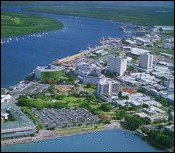



Cairns has enjoyed a rather difficult growth since the Queensland Government founded the site in 1876 and named it after the Governor at that time William Cairns.
Captain Cook went ashore on his epic voyage of discovery of 'the great south land' in 1770 when he named Trinity Bay (discovered on Trinity Sunday). Cairns was not settled until the onset of the gold rush era when gold was discovered in The Palmer River. Cooktown was the original choice for a settlement. However a handsome 300 pounds was offered to anyone able to cut a track to Trinity Bay which promised a more direct route to the coast and needless to say this was quickly accomplished. With the opening of the Government Customs Office the town was quickly established.
Cairns is surrounded on three sides by rainforest and on the fourth by the Coral Sea. Every tourist activity is outside. From white water rafting to deep sea diving to exploring the rainforest.

The Reef
One of Australia's greatest assets is the magnificent reef which runs along virtually the entire coast of Queensland. Considered one of the world's natural wonders, it is the most extensive reef system and the biggest structure made by living organisms on earth. In the north, the reef is virtually continuous and is located only 50km or so from the shore. In the south, individual reefs are more common, and in some places up to 300km offshore. We went out for a day trip snorkeling. The colorful fish, and coral were outstanding. My father went snorkeling for the first time in his life, considering he cannot swim, that was an accomplishment in itself.

The Rainforest
The World Heritage listed Wet Tropics region is a wilderness dream of lush and breathtaking beautiful tropical rainforests, deserted white beaches and crystal clear rivers. The region attracts nature lovers and backpackers seeking the perfect holiday escape. The World Heritage listed Great Barrier Reef and the rainforests of the Wet Tropics come together along the northern section of the coast - nowhere else in the world are two such natural wonders to be found side by aside and so accessible to travellers. Much of the natural world surrounding Cairns is dense and diverse. The Wet Tropics World Heritage Rainforest was set aside as a world heritage area for its scientific and cultural importance and its natural beauty. The hundreds of miles of rainforest contains the most complete and diverse record of plant evolution. It is home to dozens of rare or unique plant and animal species. We viewed the Rainforest on the skyrail. We were going to take the historic Kuranda train except there was a cyclone that hit the week before and the tracks were damaged and there was a lot of flooding.
Skyrail, Cairns

Another scenic day trip we took was a 70 km spectacular drive from Cairns by sealed road skirting the Coral Sea unique Port Douglas. Sharing the same tropical latitude as Tahiti, Port Douglas has a distinctive "laid back" low rise tropical old world charm. Port Douglas is now regarded as the most popular base from which to explore the northern areas of the Great Barrier Reef and rainforest coast of Daintree and Cape Tribulation.

The nearest township to the Great Barrier Reef and steeped in history, it was this proximity that in the 1980's saw the northís first Outer Barrier Reef cruises hasten the rebirth of this once sleepy fishing village, which in the last century rivalled Cairns as the regionís main centre and gateway to the Northís booming goldfields. Further north, between the long sandy beaches and mist capped mountains, are sugar, fruit, tea and coffee plantations, a rainforest theatre, walking tracks and mangrove board walks.
If you have any suggestions or questions email me:

| Ayers Rock | Brisbane | Main Page | Melbourne | New Zealand | Fiji | Go to top |